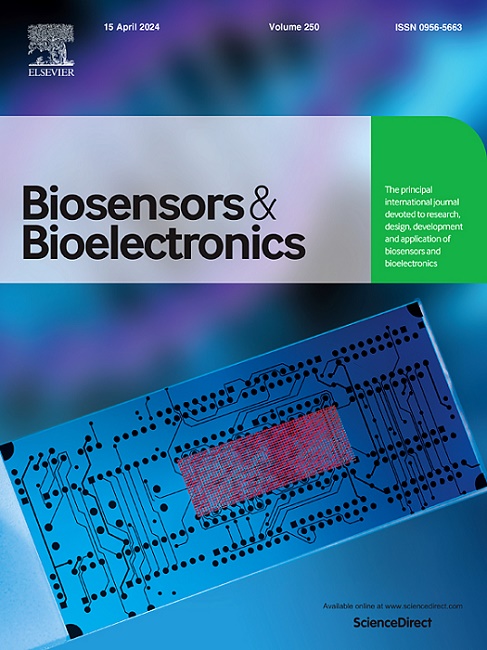Ultrasensitive SERS nanoprobe-based multiplexed digital sensing platform for the simultaneous quantification of Alzheimer's disease biomarkers
IF 10.7
1区 生物学
Q1 BIOPHYSICS
引用次数: 0
Abstract
Alzheimer's disease (AD) is a severe neurodegenerative disease that requires early diagnosis to manage its progression. Although the simultaneous detection of multiple AD biomarkers is expected to facilitate early assessment of AD risk, the lack of multiplexed sensing platforms for accurately quantifying multiple AD biomarkers remains a challenge. Here, we present a multiplexed digital sensing platform based on bumpy core–shell (BCS) surface-enhanced Raman spectroscopy (SERS) nanoprobes for ultrasensitive, quantitative, and simultaneous detection of Aβ42 and Aβ40 as AD biomarkers, enabling the accurate determination of the Aβ42/Aβ40 ratio. We synthesized BCS SERS nanoprobes with distinct Raman reporters to generate unique, intense, and reproducible SERS signals, offering single-nanoparticle sensitivity and quantification capabilities. These nanoprobes were subsequently employed in SERS-based immunoassays combined with digital SERS analysis for multiplexed quantification. The proposed platform accurately and quantitatively detected Aβ42 and Aβ40 across a range of five orders of magnitude, with a limit of detection of 8.7× 10−17 g/mL (1.9 × 10−17 M) for Aβ42 and 1.0 × 10−15 g/mL (2.3 × 10−16 M) for Aβ40, surpassing the performance of conventional enzyme-linked immunosorbent assays. Based on the exclusive detection of Aβ42 and Aβ40 using distinct SERS nanoprobes, the proposed sensing platform can also accurately quantify Aβ42 and Aβ40 at clinically relevant levels in both cerebrospinal fluid and blood plasma. Therefore, this sensing platform can be used to accurately and reliably determine the Aβ42/Aβ40 ratio, thus serving as an effective tool for the early diagnosis of AD.
阿尔茨海默病(AD)是一种严重的神经退行性疾病,需要早期诊断以控制病情发展。虽然同时检测多种阿尔茨海默病生物标志物有望促进对阿尔茨海默病风险的早期评估,但缺乏可准确量化多种阿尔茨海默病生物标志物的多重传感平台仍是一项挑战。在这里,我们提出了一种基于凹凸核壳(BCS)表面增强拉曼光谱(SERS)纳米探针的多重数字传感平台,用于超灵敏、定量和同时检测作为AD生物标志物的Aβ42和Aβ40,从而准确测定Aβ42/Aβ40的比值。我们合成了具有独特拉曼报告器的 BCS SERS 纳米探针,以产生独特、强烈和可重现的 SERS 信号,提供单纳米粒子灵敏度和定量能力。这些纳米探针随后被用于基于 SERS 的免疫测定,并结合数字 SERS 分析进行多重定量。所提出的平台可在五个数量级的范围内准确定量检测 Aβ42 和 Aβ40,Aβ42 的检测限为 8.7×10-17 g/mL(1.9×10-17 M),Aβ40 的检测限为 1.0×10-15 g/mL(2.3×10-16 M),超过了传统的酶联免疫吸附测定法。基于使用不同的 SERS 纳米探针对 Aβ42 和 Aβ40 进行独家检测,所提出的传感平台还能在脑脊液和血浆中精确定量临床相关水平的 Aβ42 和 Aβ40。因此,该传感平台可用于准确可靠地测定 Aβ42/Aβ40 比值,从而成为早期诊断老年痴呆症的有效工具。
本文章由计算机程序翻译,如有差异,请以英文原文为准。
求助全文
约1分钟内获得全文
求助全文
来源期刊

Biosensors and Bioelectronics
工程技术-电化学
CiteScore
20.80
自引率
7.10%
发文量
1006
审稿时长
29 days
期刊介绍:
Biosensors & Bioelectronics, along with its open access companion journal Biosensors & Bioelectronics: X, is the leading international publication in the field of biosensors and bioelectronics. It covers research, design, development, and application of biosensors, which are analytical devices incorporating biological materials with physicochemical transducers. These devices, including sensors, DNA chips, electronic noses, and lab-on-a-chip, produce digital signals proportional to specific analytes. Examples include immunosensors and enzyme-based biosensors, applied in various fields such as medicine, environmental monitoring, and food industry. The journal also focuses on molecular and supramolecular structures for enhancing device performance.
 求助内容:
求助内容: 应助结果提醒方式:
应助结果提醒方式:


